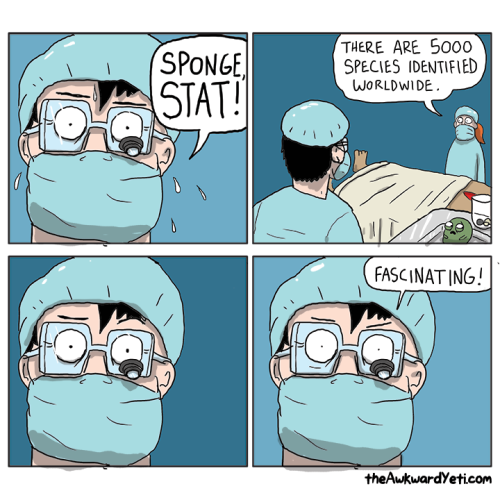Miscellaneous thoughts on politics, people, math, science and other cool (if sometimes frustrating) stuff from somewhere near my favorite coffee shop.
Saturday, April 5, 2014
Geo 730: April 5, Day 460: Attachment Scars II
Another view of attachment scars on the tsunami dock. Again, I'm not enough of a bio person to have any real idea what I'm looking at. The circular spots look as if they might be some kind of barnacle; I was thinking perhaps cnidarians, sort of like sea anemones, but I don't know if any of those precipitate a calcareous base. Just in a bit from the upper left corner, and not really visible at this scale (right-click the photo, open in new tab for full-size), it looks as if there are the remains of an encrusting bryzoan of some kind. Spots where tube worms were cemented on are visible in several places. Finally, in the bottom middle and lower right corner, it looks like the greenish splotches were a variety of calcareous algae.
Photo unmodified. July 10, 2012. FlashEarth location (approximate).
Photo unmodified. July 10, 2012. FlashEarth location (approximate).
Friday, April 4, 2014
Geo 730: April 4, Day 459: Attachment Scars I
A variety of organisms colonized the concrete exterior of the dock while it rested in its home harbor in Japan. Many, if not most, of them survived their ride across the Pacific Ocean, a duration of about 15 months. This was unexpected. When the dock grounded at Agate Beach, it was heavily coated with these creatures. They were removed with a combination of scraping and pressurized steam. As I mentioned Sunday, my suspicion is that if they were truly aggressive invasive species, this effort may have been too little, too late. On the other hand, killing and removing them as quickly as possible does decrease the likelihood that a reproducing, expanding population can be established. So I'm not criticizing the effort, just pointing out that it guarantees nothing. Plus, I should state clearly, I'm not really any kind of authority on biology, let alone the niceties of invasive species from Japan that might become established in PNW coastal waters.
The only ones of these scars that I think I recognize with any confidence are the tubeworms. There are several good examples, lower left corner, a bit farther in from the upper left corner, and a third in the upper center.
Photo unmodified. July 10, 2012. FlashEarth location (approximate).
The only ones of these scars that I think I recognize with any confidence are the tubeworms. There are several good examples, lower left corner, a bit farther in from the upper left corner, and a third in the upper center.
Photo unmodified. July 10, 2012. FlashEarth location (approximate).
Thursday, April 3, 2014
Geo 730: April 3, Day 458: Wrecked Tangle
One of the many benefits of doing this series is that it requires me to spend some time each day looking over a few photos, which not only requires me to review what I know about the location, but also, inevitably, raises new questions. On occasion, following photos can give me an insight into answering some of those questions. Had you asked me yesterday or the day before what the purpose of the I-beams (three of which were torn out during the tsunami; above is the one remaining) on the ends of the dock, I would've guessed some kind of spacers. But the photo above suggests a slightly different purpose. It still has a roller attached to it. Imagining the others had a similar configuration, I picture four sturdy poles, one at each corner, anchored in the harbor floor. The pairs of rollers on each corner would allow the dock to move up and down with the tides, but constrain horizontal motion, exactly as commenter Skinny Dennis said on Tuesday. At least until the great wave hit.
Photo unmodified. July 10, 2012. FlashEarth location (approximate).
Photo unmodified. July 10, 2012. FlashEarth location (approximate).
Wednesday, April 2, 2014
Geo 730: April 2, Day 457: I Of The Storm
Here's a close-up view of the twisted remains of the only remaining I-beam on the end of the tsunami dock. There's not much for scale in this photo, but yesterday's gives a pretty good sense. The way the steel is sheared, torn and warped is humbling. Looking at the base, you can also see that this one came very close to being torn out as well; the concrete is broken, revealing the rebar reinforcement underneath.
Photo unmodified. July 10, 2012. FlashEarth location (approximate).
Photo unmodified. July 10, 2012. FlashEarth location (approximate).
Tuesday, April 1, 2014
Geo 730: April 1, Day 456: Monocular
Monocular as in missing an I. Of the four I beams originally mounted on this dock, I imagine as spacers, though I'm not really confident, only this one remained. As with the two at the other end, the missing one on the right was torn out despite being anchored in a web of rebar. I don't even have a guess as to the purpose of the rollers on the dock's upper surface. The "No Trespassing" stencils were an attempt to keep visitors from climbing up onto the structure, and were not terribly successful. There were at least two kids up there during a part of our visit, who must have had a boost from parents. My recollection is that the powers that be were concerned about the dangers of falling off.
Photo unmodified. July 10, 2012. FlashEarth location (approximate).
Photo unmodified. July 10, 2012. FlashEarth location (approximate).
Monday, March 31, 2014
Geo 730: March 31, Day 455: Trans-Pacific Express
I'll grant the post title is more than a bit hyperbolic, but there's no doubt the arrival of this dock took everyone by surprise. The arrival of tsunami debris was anticipated (and still more is expected, even now), but the dock came much more quickly than anyone guessed it might. In retrospect, if one looks at the debris that has already arrived, it tends to be high-buoyancy, high-profile objects: blocks of Styrofoam, unswamped boats- that is, ones that are still upright, with a minimum of water in their interiors, this dock, and another almost identical one near Forks, Washington. All of these objects would sit high in the water, minimizing drag with respect to the ocean, but maximizing it with respect to the wind. In other words, I suspect the reason they arrived sooner than expected was that the objects themselves acted, in a sense, as sails, increasing the speed with which they were able to traverse the largest body of water on earth.
Photo unmodified. July 10, 2012. FlashEarth location (approximate).
Photo unmodified. July 10, 2012. FlashEarth location (approximate).
Sunday, March 30, 2014
Sunday Funnies: Spring Edition
Cheezburger
Bits and Pieces
Are You Talking to Meme?
Tastefully Offensive
Bits and Pieces
"The lava game IRL" Senor Gif
The Gentleman's Armchair
Wil Wheaton
The Awkward Yeti
Very Demotivational
Senor Gif
Blackadder
Tastefully Offensive
Shannon Wheeler
Funny to Me
"You had one job..." Bits and Pieces
Blackadder
Cheezburger
Funny to Me
Just an Earth-Bound Misfit
Partially Clips
Wil Wheaton
Maximumble
Cyanide and Happiness
Bits and Pieces
Texts From TNG
Wil Wheaton
Bizarro
Bad Newspaper
Are You Talking to Meme?
Tastefully Offensive
Dork Tower
Very Demotivational
Senor Gif
Tastefully Offensive
Tastefully Offensive
Gemma Correll
Poorly Drawn Lines
Cheezburger
Bits and Pieces
Are You Talking to Meme?
Tastefully Offensive
Bits and Pieces
"The lava game IRL" Senor Gif
The Gentleman's Armchair
Wil Wheaton
Very Demotivational
Senor Gif
Blackadder
Tastefully Offensive
Shannon Wheeler
Funny to Me
"You had one job..." Bits and Pieces
Blackadder
Cheezburger
Funny to Me
Just an Earth-Bound Misfit
Partially Clips
Wil Wheaton
Maximumble
Cyanide and Happiness
Bits and Pieces
Texts From TNG
Wil Wheaton
Bizarro
Bad Newspaper
Are You Talking to Meme?
Tastefully Offensive
Dork Tower
Very Demotivational
Senor Gif
Tastefully Offensive
Tastefully Offensive
Gemma Correll
Poorly Drawn Lines
Cheezburger
Geo 730: March 30, Day 454: Scars
The height of this dock above the waterline was about 7 or 8 feet, for a sense of scale. Here we see where the I-bars were ripped away from the rebar in the dock's interior structure. In addition to the damage wrought by the tsunami, note the ubiquitous attachment scars where marine organisms colonized the surface. One of the first things done after the dock landed was to scrape, scour and burn off these organisms, some of which may pose an invasive threat to our waters. I'm skeptical of the efficacy of this move, but no harm in trying, I guess.
Photo unmodified. July 10, 2012. FlashEarth location (approximate).
Photo unmodified. July 10, 2012. FlashEarth location (approximate).









































